As much as I labored in my decision of which Oldsmobile I would choose in my recent Top 10 list, selecting the worthiest Buick has presented the same predicament. There are two distinct Buicks that deserve to be in my Top 10 list, namely the 1970 Buick GSX and the 1986 to 1987 Buick Grand National.
Back in the baby boomer muscle car era things were much different to what they are today. Autonomy was the rule in the 1960s as each GM manufacturer, ala Olds 442, Buick GS, Chevrolet SS and Pontiac GTO, all built their own engines. Sharing engines was not an option. Of this class of muscle car, the Buick was usually the slowest of the bunch in showroom trim – that is until 1970 when the Buick GSX Stage 1 arrived at the dealership.
If ever there was a sleeper from the original class of muscle cars, it was indeed the 1970 Buick GSX. With less than 700 produced, this 455-inch Buick engine produced 390 horses and more torque than the 426 Hemi. With proper gearing it could outrun just about every car produced that year and is a favorite of muscle car collectors nationwide. In strict factory showroom trim, the 1970 Buick GSX 455 could run with and even beat a showroom stock Dodge or Plymouth 426 Hemi.
My memories recall a Motor Trend Magazine feature in 1970 that found the Buick GSX 455 with its 510 lb. ft. of torque up against a bunch of other muscle cars that year, including a 426 Hemi and a 440 GTX. The Buick, with an automatic transmission, ran the quickest of them all with a 13.38 quarter mile run at 105.5 with a 3:64 gear. The Hemi I recall had 3:23 gears and an automatic and I believe it ran in the 13.50 range.
Because less than 700 were built, it makes sense that on your city’s boulevard you probably never lined up against one. However, I’ll again stress that in 1970, the Buick GSX455 was one of the most potent muscle cars of all-time.
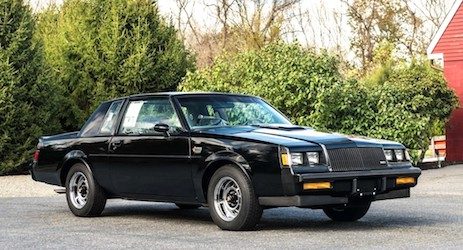
Our author had a rough time choosing which Buick model should join his personal Top 10 muscle car list. He explains in detail why he made his selection between the 1970 Buick GNX and the 1986-1987 Buick Grand National. You’ll have to read on to find out his selection. Pictured is a 1987 Buick Grand National. (Mecum Auctions)
Before we get to the 1986-87 Buick Grand National GNX, a little Buick history is needed. Buick began producing horseless carriages in 1903 utilizing a chain driven twin-power engine. The inventor was David Buick, a Scottish industrialist who was best known at the time for inventing the process of applying porcelain to steel tubs.
His Buick Motor Company grew by leaps and bounds to the point where William Durant purchased it in 1908 to be the first brand of the new General Motors offerings. The Buick line was favored by professionals, lawyers, businesspeople and doctors, and followed Chevy, Oakland (Pontiac) and Oldsmobile in the GM pecking order. Cadillac was next up after Buick as its top line luxury car.
All Buicks used in-line six-cylinder engines until 1931, when the first “straight eight” Buick appeared and would be the favored power plant of all Buicks for 22 years. In 1953, Buick introduced a 12-volt electrical system and power steering, but the big news was the release of its first ever V8 engine for the Roadmaster and Super lines. These Fireball V-8 engines arrived at 322 inches and would grow through the years up to 401 inches in 1961.
New V8 designs arrived in 1964, and styling improved as the years went by. All the while Buick still catered to the successful older crowd, but the kids of these upper middle-class individuals also had a Buick of their own to drive, as the Gran Sport offered great looks and muscle car performance. It culminated in 1970, as the GSX was a feared competitor and featured a 455-inch powerhouse under the hood.
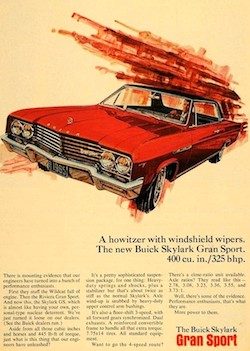
The very first Buick intermediate muscle car was the 1965 Buick Skylark Gran Sport, powered by a 401 V-8 putting out 325 horsepower. (Buick)
Buick, in my opinion, was forced to enter the high-performance fray with its mid-size 1965 Skylark GS (Gran Sport) featuring a new 401-inch V8, but marketed as a 400 ala corporate mandates. It put out 325 horses initially, and then grew into street and strip prominence as horsepower increased through the years with Stage I and Stage II engine options.
My personal Buicks included a 1951 Buick Special coupe purchased in 1972, and a beautiful all white 1983 Park Avenue I bought in 1986 for my growing family. Both are long gone now, and the day I sold the ’51 still ranks as one of my biggest “no-no” days.
The fitting muscle car tribute came in 1970 when General Motors gave the green light to a 455-inch GS, with an even faster GSX model available for the ultimate thrill seeker. Two 455’s were available, notably the 350 horse “normal” 455 that also came with the standard GS, or the 455 Stage I option that 400 of the 687 GSX buyers purchased that year.
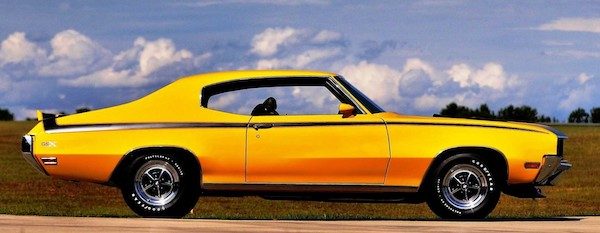
The 1970 Buick GSX is regarded as one of the fastest bone-stock muscle cars ever built by General Motors. With a 455-inch V-8 under the hood and 510 lb. ft. of torque, this heavy intermediate accelerated to 60 mph in just 5.5 seconds. (Mecum Auctions)
Only two colors were available in the 1970 GSX line, Saturn yellow or Apollo white. The GSX also sported special black stripes along the sides that ran over a special GSX rear spoiler, while the operating ram air hood featured black stripes and a hood mounted tachometer.
The Stage I engine found Buick engineers adding a higher lift cam and larger valve heads to produce 360 underrated horsepower with a single Quadrajet carburetor. Car experts agree that the Stage I 455 produced a minimum of 425 horses, as its torque rating of 510 lb. ft. is the highest ever for any muscle car of the era. The Stage I option was only $113 more than the standard 350-horse 455.
The proof of GSX’s superiority, however, came when a Stage I GSX, carrying 3,561 pounds of mass, scooted to 60-MPH in just 5.5-seconds and ran the quarter mile on street tires in 13.3 at 107. These strictly stock numbers were better than many 426 Street Hemi Plymouths and Dodges, making the 1970 GSX one of the industry’s top “sleeper” cars of all time.
Today, a 1970 GSX at a Mecum or Barrett-Jackson auction will go for $125,000 or more, proving that the GSX is a true collector gem highlighting Buick affluence merges with lethal horsepower.
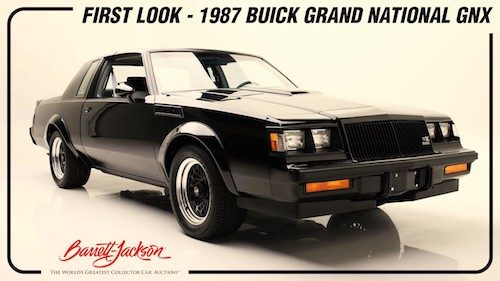
Buick built one of the fastest production cars ever with its 1986-1987 Grand National, powered by a turbocharged V-6 engine. In the right hands and a few turbo adjustments, it was just as fast as the GSX. Shown is the limited edition GNX, which stands for Grand National Experimental. (Barrett-Jackson)
Now onto the dilemma. To not consider the ’86-’87 Buick Grand National for a spot on the Top 10 list would be an injustice as clearly the 1980 decade was not known for muscle car performance. These Buicks first arrived in 1982 in Regal Sport dress, and in 1984 they featured a turbo. Yet it took until 1986 for the first “really fast” turbo V-6 Grand National to arrive, thanks to Buick engineers working in tandem with topflight racing engineers and a corporate Buick V-6 IndyCar program started by Buick GM Lloyd Reuss in late 1981.
Buick engineers accomplished the Grand National feat utilizing the same 3.6-liter turbo V-6 with a new air-to-air intercooler working wonders between the throttle body and turbo. Horsepower improved to a “reported” 235, and then in 1987 up to 245 thanks to tweaked and upward boost numbers. The result was zero to 60 in just 6.1 seconds and low to mid 13s in the quarter mile.
Like the ’69 Hurst/Olds selected over the 442 in the last installment of this series, the Buick Grand National also had a specially built sibling to offer called Buick GNX. Built by ASC/McLaren in 1987, it was a more powerful and flashy version of which only 547 units were sold. However, 5,512 “normal” Grand Nationals were sold in ’86 while in ’87, another 20,740 Grand Nationals were delivered. Then, without notice, Buick pulled the plug and the fabulous Buick Grand National was finished.
Having participated on a Turbo Seminar panel with turbo genius and Buick V-6 legend Ken Duttweiler in 2016 at the PRI Show in Indianapolis, Duttweiler admitted that Buick VIPs were never really behind the 1986-1987 Grand National effort, and corporate didn’t realize nor care it was sitting on advanced turbo technology necessary for future, muscle car development.
Unfortunately, this fact is proven as Buick stopped making the potent Grand National in 1988, leaving behind what could have been a muscle car more famous than the 1970 GSX.
Considering everything, my official 8th choice is… the 1970 Buick GSX, because Buick was 100% behind this effort while dropping the ball on the Grand National effort.
We have two more Top 10 cars to go, but I’ll need a few weeks to finish number nine. Next week we’ll hit the overflowing mailbag.
(Greg Zyla is a syndicated auto columnist who writes weekly feature stories on collector cars, auto nostalgia and motorsports. He welcomes reader interaction at greg@gregzyla.com or snail mail to Greg at Roosevelt St., Sayre, Pa. 18840.)

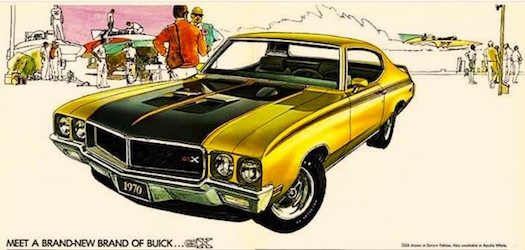

Be the first to comment on "Collector Car / Cars We Remember; Eighth in a series of Top 10 Muscle Cars of All-Time: The Buick dilemma"